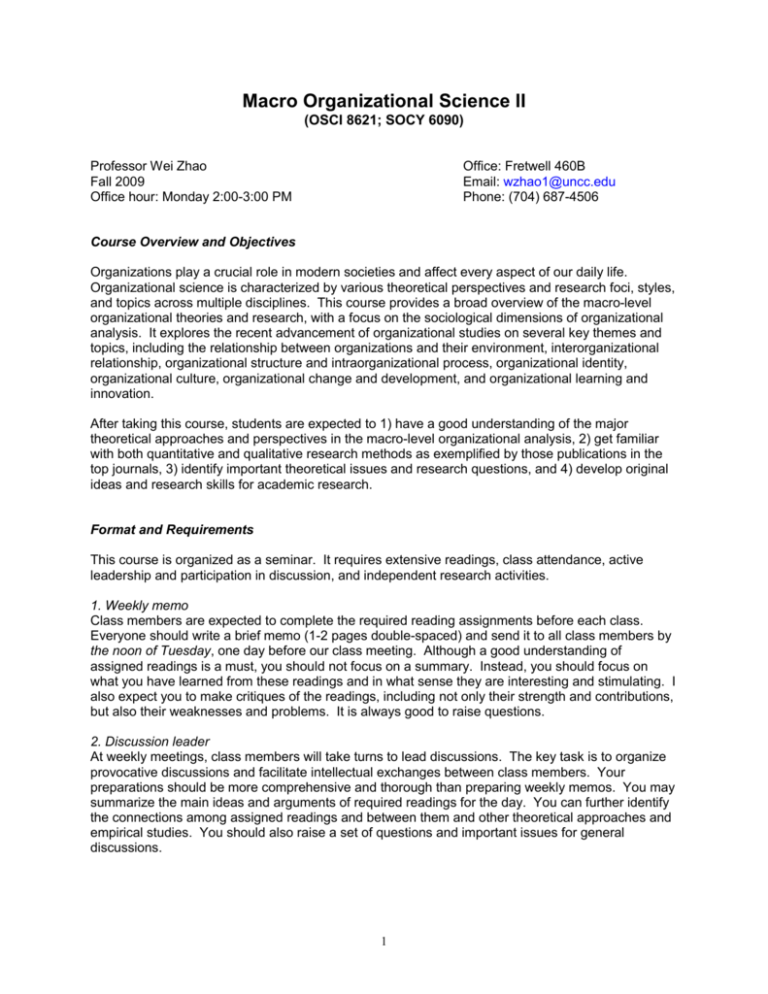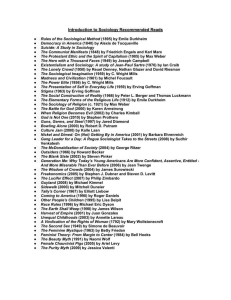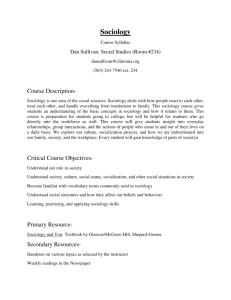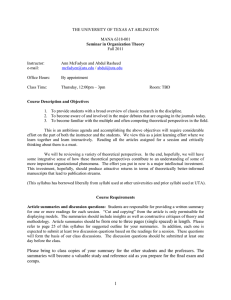
Macro Organizational Science II
(OSCI 8621; SOCY 6090)
Professor Wei Zhao
Fall 2009
Office hour: Monday 2:00-3:00 PM
Office: Fretwell 460B
Email: wzhao1@uncc.edu
Phone: (704) 687-4506
Course Overview and Objectives
Organizations play a crucial role in modern societies and affect every aspect of our daily life.
Organizational science is characterized by various theoretical perspectives and research foci, styles,
and topics across multiple disciplines. This course provides a broad overview of the macro-level
organizational theories and research, with a focus on the sociological dimensions of organizational
analysis. It explores the recent advancement of organizational studies on several key themes and
topics, including the relationship between organizations and their environment, interorganizational
relationship, organizational structure and intraorganizational process, organizational identity,
organizational culture, organizational change and development, and organizational learning and
innovation.
After taking this course, students are expected to 1) have a good understanding of the major
theoretical approaches and perspectives in the macro-level organizational analysis, 2) get familiar
with both quantitative and qualitative research methods as exemplified by those publications in the
top journals, 3) identify important theoretical issues and research questions, and 4) develop original
ideas and research skills for academic research.
Format and Requirements
This course is organized as a seminar. It requires extensive readings, class attendance, active
leadership and participation in discussion, and independent research activities.
1. Weekly memo
Class members are expected to complete the required reading assignments before each class.
Everyone should write a brief memo (1-2 pages double-spaced) and send it to all class members by
the noon of Tuesday, one day before our class meeting. Although a good understanding of
assigned readings is a must, you should not focus on a summary. Instead, you should focus on
what you have learned from these readings and in what sense they are interesting and stimulating. I
also expect you to make critiques of the readings, including not only their strength and contributions,
but also their weaknesses and problems. It is always good to raise questions.
2. Discussion leader
At weekly meetings, class members will take turns to lead discussions. The key task is to organize
provocative discussions and facilitate intellectual exchanges between class members. Your
preparations should be more comprehensive and thorough than preparing weekly memos. You may
summarize the main ideas and arguments of required readings for the day. You can further identify
the connections among assigned readings and between them and other theoretical approaches and
empirical studies. You should also raise a set of questions and important issues for general
discussions.
1
3. Class discussion
Because we will work as a group to study these readings together, active participation in class
discussion is essential to the success of this course. You are expected to answer the questions
raised by the discussion leader, make comments on classmates’ memos, and identify good
examples on related organizational phenomena. In particular, you need to propose what new
research ideas and projects may be further developed from the extant research, and what new data
and research methods may be used to extend the research.
4. Final paper
The final paper (15-20 pages double-spaced) may take one of the following three forms: 1) A
research proposal that focuses on one important research question, articulates a theoretical
framework and several hypotheses, and develops a research design for an empirical study; 2) A
grant proposal that can be revised to apply for the external research funding; 3) A complete research
paper that can be revised and expanded into a standard journal article. Any of these should be
related to the macro-level organizational analysis. You will present your final paper at the end of this
semester and receive constructive feedbacks from the whole class.
Grading
Your final grade will be reckoned based on the following evaluations and scale:
weekly memos (20%); discussion leadership (20%); class discussion (20%); final paper (40%)
A = 90 – 100; B = 80 – 89; C = 70 – 79; U < 70
Course Policies
I will not grade late assignments. Students must observe university policies on Course Attendance
(http://www.provost.uncc.edu/catalogs/1995-1997/ugrad/attend.html) and Academic Integrity
(http://www.legal.uncc.edu/policies/ps-105.html). All work by students is subject to the standards of
“The UNCC Code of Student Academic Integrity,” and students should have a clear understanding of
the definitions of and penalties for violation.
Textbook
Scott, W. Richard and Gerald F. Davis. 2007. Organizations and Organizing: Rational, Natural, and
Open System Perspectives. Upper Saddle River, NJ: Pearson Prentice Hall. (ISBN: 0-13-195893-3)
Class Schedule and Readings (supplementary readings marked with *)
Aug. 26
Course introduction & discussions on organizational phenomena
Sept. 2
Organizations in modern societies
Scott and Davis. 2007. Chapter 13: The Rise and Transformation of the Corporate Form
Chapter 1: The Subject is Organizations; The Verb is Organizing
2
Weber, Max. 1968. trans. “Bureaucracy” Pp. 956-1005, in Economy and Society, edited by Guenther
Roth and Claus Wittich. New York, NY: Bedminister Press.
Hamilton, Gary G. and Nicole Woolsey Biggart. 1988. “Market, Culture, and Authority: A
Comparative Analysis of Management and Organization in the Far East.” American Journal
of Sociology 94: S52-S94.
* Stinchcombe, Arthur L. 1965. “Social Structure and Organizations.” Pp. 142-193 in Handbook of
Organizations, edited by James G. March. Chicago, IL: Rand McNally.
Sept. 9
Organizational theories
Scott and Davis. 2007. Chapter 2: Organizations as Rational Systems
Chapter 3: Organizations as Natural Systems
Chapter 4: Organizations as Open Systems
Chapter 5: Combining Perspectives, Expanding Levels
Sept. 16
Organizations and environment (I)
Scott, Richard W. 2004. “Reflections on a Half-Century of Organizational Sociology.” Annual Review
of Sociology 30: 1-21.
Scott and Davis. 2007. Chapter 10: Organization of the Environment
Meyer, John W. and Brian Rowan. 1977. “Institutionalized Organizations: Formal Structure as Myth
and Ceremony.” American Journal of Sociology 83: 340-363.
DiMaggio, Paul J. and Walter W. Powell. 1983. “The Iron Cage Revisited: Institutional Isomorphism
and Collective Rationality in Organizational Fields.” American Sociological Review 48: 147160.
* DiMaggio, Paul J. and Walter W. Powell. 1991. “Introduction.” Pp.1-38 in The New Institutionalism
in Organizational Analysis, edited by Walter W. Powell and Paul J. DiMaggio. Chicago, IL:
The University of Chicago Press.
* Hirsch, Paul M. and Michael Lounsbury. 1997. “Ending the Family Quarrel: Toward a
Reconciliation of ‘Old’ and ‘New’ Institutionalisms.” The American Behavioral Scientist 40:
406-418.
Sept. 23
Organizations and environment (II)
Guler, Isin, Mauro F. Guillén, and John Muir Macpherson. 2002. “Global Competition, Institutions,
and the Diffusion of Organizational Practices: The International Spread of ISO 9000 Quality
Certificates.” Administrative Science Quarterly 47: 207-232.
Hirsh, C. Elizabeth and Sabino Kornrich. 2008. “The Context of Discrimination: Workplace
Conditions, Institutional Environments, and Sex and Race Discrimination Charges.”
American Journal of Sociology 113: 1394-1432.
3
Zilber, Tammar B. 2006. “The Work of the Symbolic in Institutional Processes: Translations of
Rational Myths in Israeli High Tech.” Academy of Management Journal 44: 281-303.
* Sutton, John R. and Frank Dobbin. 1996. “The Two Faces of Governance: Responses to Legal
Uncertainty in U.S. Firms, 1955 to 1985.” American Sociological Review 61: 794-811.
* Edelman, Lauren. 1990. “Legal Environments and Organizational Governance: The Expansion of
Due Process in the American Workplace.” American Journal of Sociology 95: 1401-1440.
* Thornton, Patricia H. and William Ocasio. 1999. “Institutional Logics and the Historical Contingency
of Power in Organizations: Executive Succession in the Higher Education Publishing
Industry, 1958-1990.” American Journal of Sociology 105: 801-843.
Sept. 30
Interorganizational relationship (I)
Scott and Davis. 2007. Chapter 11: Networks In and Around Organizations
Uzzi, Brian. 1997. “Social Structure and Competition in Interfirm Networks: The Paradox of
Embeddedness.” Administrative Science Quarterly 42: 35-67.
Powell, Walter W. 1990. “Neither Market Nor Hierarchy: Network Forms of Organization.” Research
in Organizational Behavior 12: 295-336.
* Granovetter, Mark. 1985. “Economic Action and Social Structure: The Problem of Embeddedness.”
American Journal of Sociology 91: 481-510.
* Podolny, Joel M. and Karen L. Page. 1998. “Network Forms of Organization.” Annual Review of
Sociology 24: 57-76.
* Podolny, Joel M. 2005. “Networks as the Pipes and Prisms of the Market.” American Journal of
Sociology 107: 33-60.
Oct. 7
Interorganizational relationship (II)
Uzzi, Brian and Ryon Lancaster. 2004. “Embeddedness and Price Formation in the Corporate Law
Market.” American Sociological Review 69: 319-344.
Hansen, Morten T. 1999. "The Search-Transfer Problem: The Role of Weak Ties in Sharing
Knowledge across Organization Subunits." Administrative Science Quarterly 44: 82-111.
Stark, David and Balázs Vedres. 2006. “Social Times of Network Spaces: Network Sequences and
Foreign Investment in Hungary.” American Journal of Sociology 111: 1367-1411.
Dyer, Jeffrey H. and Kentaro Nobeoka. 2000. “Creating and Managing A High-Performance
Knowledge-Sharing Network: The Toyota Case.” Strategic Management Journal 21: 345367.
* Davis, Gerald F. and Henrich R. Greve. 1997. “Corporate Elite Networks and Governance
Changes in the 1980s.” American Journal of Sociology 103: 1-37.
4
* Obstfeld, David. 2005. “Social Networks, the Tertius Iungens Orientation, and Involvement In
Innovation.” Administrative Science Quarterly 50: 100-130.
Oct. 14
Organizational structure, HRM, and intraorganizational process (I)
Scott and Davis. 2007. Chapter 6: Technology and Structure
Chapter 7: Labor and Structure
Chapter 8: Goals, Power, and Control
Chapter 12: Strategy, Structure, and Performance
Oct. 21
Organizational structure, HRM, and intraorganizational process (II)
Reskin, Barbara F. and Debra Branch McBrier. 2000. “Why Not Ascription? Organizations’
Employment of Male and Female Managers.” American Sociological Review 65: 210-233.
Huselid, Mark A. 1995. “The Impact of Human Resource Management Practices on Turnover,
Productivity, and Corporate Financial Performance.” Academy of Management Journal 38:
635-672.
Podolny, Joel M. and James N. Baron. 1997. “Resources and Relationships: Social Networks and
Mobility in the Workplace.” American Sociological Review 62: 673-693.
* Kalev, Alexandra. 2009. “Cracking the Glass Cages? Restructuring and Ascriptive Inequality at
Work.” American Journal of Sociology 114: 1591-1643.
* Seibert, Scott E., Maria L. Kraimer, and Robert C. Liden, 2001. "A Social Capital Theory of Career
Success." Academy of Management Journal 44: 219-237.
* Fernandez, Roberto M., Emilio J. Castilla, and Paul Moore. 2000. “Social Capital at Work:
Networks and Employment at a Phone Center.” American Journal of Sociology 105: 12881356.
Oct. 28
Organizational identity
Dutton, Jane E. and Janet M. Dukerich, 1991. "Keeping an Eye on the Mirror: Image and Identity in
Organizational Adaptation." Academy of Management Journal 34: 517-554.
Pratt, Michael G. 2000. “The Good, the Bad, and the Ambivalent: Managing Identification among
Amway Distributors.” Administrative Science Quarterly 45: 456-493.
Zuckerman, Ezra W. 1999. “The Categorical Imperative: Securities Analysts and the Illegitimacy
Discount.” American Journal of Sociology 104: 1398-1438.
* Albert, Stuart and David A. Whetten. 1985. “Organizational Identity.” Research in Organizational
Behavior 7: 263-95.
* Hsu, Greta and Michael T. Hannan. 2005. "Identities, Genres, and Organizational Forms."
Organization Science 16: 474-490.
5
* Carroll, Glenn R. and Anand Swaminathan. 2000. “Why the Microbrewery Movement?
Organizational Dynamics of Resource Partitioning in the U.S. Brewing Industry.” American
Journal of Sociology 106: 715-762.
* Dutton, Jane E., Janet M. Dukerich, and Celia V. Harquail. 1994. "Organizational Images and
Member Identification." Administrative Science Quarterly 39: 239-263.
Nov. 4
Organizational culture
Weick, Karl E. 1993. “The Collapse of Sensemaking in Organizations: The Mann Gulch Disaster.”
Administrative Science Quarterly 38: 628-652.
Denison, Daniel R. and Aneil K. Mishra. 1995. “Toward a Theory of Organizational Culture and
Effectiveness.” Organization Science 6: 204-223.
Ely, Robin J. and David A. Thomas. 2001. “Cultural Diversity at Work: The Effects of Diversity
Perspectives on Work Group Processes and Outcomes.” Administrative Science Quarterly
46: 229-273.
* Barley, Stephen R., Gordon W. Meyer, and Debra C. Gash. 1988. “Cultures of Culture: Academics,
Practitioners and the Pragmatics of Normative Control.” Administrative Science Quarterly 33:
24-60.
Nov. 11
Organizational change and development
Greenwood, Royston and C. R. Hinings. 1996. “Understanding Radical Organizational Change:
Bringing Together the Old and the New Institutionalism.” Academy of Management Review
21: 1022-1054.
Leblebici, Huseyin, Gerald R. Salancik, Anne Copay, and Tom King. 1991. “Institutional Change and
the Transformation of Interorganizational Fields: An Organizational History of the U.S. Radio
Broadcasting Industry.” Administrative Science Quarterly 36: 333-363.
Haveman, Heather A., Hayagreeva Rao, and Srikanth Paruchuri. 2007. “The Winds of Change: The
Progressive Movement and the Bureaucratization of Thrift.” American Sociological Review
72: 114-142.
* Rao, Hayagreeva, Philippe Monin, and Rodolphe Durand. 2003. “Institutional Change in Toque
Ville: Nouvelle Cuisine as an Identity Movement in French Gastronomy.” American Journal of
Sociology 2003: 795-843.
* Seo, Myeong-Gu and W. E. Douglas Creed. 2002. “Institutional Contradictions, Praxis, and
Institutional Change: A Dialectical Perspective.” Academy of Management Review 27: 222247.
Nov. 18
Organizational learning and innovation
Powell, Walter W., Kenneth W. Koput, and Laurel Smith-Doerr. 1996. "Interorganizational
Collaboration and the Locus of Innovation: Networks of Learning in Biotechnology."
Administrative Science Quarterly 41: 116-145.
6
Sørensen, Jesper B. and Toby E. Stuart. 2000. "Aging, Obsolescence, and Organizational
Innovation." Administrative Science Quarterly 45: 81-112.
Elsbach, Kimberly D. and Roderick M. Kramer. 2003. “Assessing Creativity in Hollywood Pitch
Meetings: Evidence for A Dual-Process Model of Creativity Judgment.” Academy of
Management Journal 46: 283-301.
* Ferlie, Ewan, Louise Fitzgerald, Martin Wood, and Chris Hawkins. 2005. "The Nonspread of
Innovations: The Mediating Role of Professionals." Academy of Management Journal 48:
117-134.
* Eisenhardt, Kathleen M. and Behnam N. Tabrizi. 1995. "Accelerating Adaptive Processes: Product
Innovation in the Global Computer Industry." Administrative Science Quarterly 40: 84-110.
Nov. 25
No class (Thanksgiving holiday)
Dec. 2
Future of organizational sociology
Scott and Davis. 2007. Chapter 14: Changing Contours of Organizations and Organization Theory
Haveman, Heather A. 2000. “The Future of Organizational Sociology: Forging Ties among
Paradigms.” Contemporary Sociology 29: 476-486.
Westphal, James D., Ranjay Gulati, and Stephen M. Shortell. 1997. “Customization or Conformity?
An Institutional and Network Perspective on the Content and Consequences of TQM
Adoption.” Administrative Science Quarterly 42: 366-394.
Zilber, Tammar B. 2002. “Institutionalization as An Interplay between Actions, Meanings, and Actors:
The Case of A Rape Crisis Center in Israel.” Academy of Management Journal 45: 234-254.
* Elsbach, Kimberly D. 1994. “Managing Organizational Legitimacy in the California Cattle Industry:
The Construction and Effectiveness of Verbal Accounts.” Administrative Science Quarterly
39: 57-88.
* Rao, Hayagreeva, Gerald F. Davis, and Andrew Ward. 2000. “Embeddedness, Social Identity and
Mobility: Why Firms Leave the NASDAQ and Join the New York Stock Exchange.”
Administrative Science Quarterly 45: 268-292.
* Zhou, Xueguang, Wei Zhao, Qiang Li, and He Cai. 2003. “Embeddedness and Contractual
Relationships in China’s Transitional Economy.” American Sociological Review 68: 75-102.
* Sherer, Peter and Kyungmook Lee. 2002. "Institutional Change in Large Law Firms: A Resource
Dependency and Institutional Perspective." Academy of Management Journal 45: 102-119.
Dec. 9
Student presentations
Dec. 16 (final exam time)
Student presentations
7










